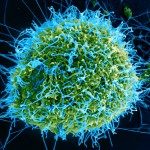Link to Pubmed [PMID] – 15218022
J. Biol. Chem. 2004 Aug;279(35):36625-32
By frequently rearranging large regions of the genome, genetic recombination is a major determinant in the plasticity of the human immunodeficiency virus type I (HIV-1) population. In retroviruses, recombination mostly occurs by template switching during reverse transcription. The generation of retroviral vectors provides a means to study this process after a single cycle of infection of cells in culture. Using HIV-1-derived vectors, we present here the first characterization and estimate of the strength of a recombination hot spot in HIV-1 in vivo. In the hot spot region, located within the C2 portion of the gp120 envelope gene, the rate of recombination is up to ten times higher than in the surrounding regions. The hot region corresponds to a previously identified RNA hairpin structure. Although recombination breakpoints in vivo cluster in the top portion of the hairpin, the bias for template switching in this same region appears less marked in a cell-free system. By modulating the stability of this hairpin we were able to affect the local recombination rate both in vitro and in infected cells, indicating that the local folding of the genomic RNA is a major parameter in the recombination process. This characterization of reverse transcription products generated after a single cycle of infection provides insights in the understanding of the mechanism of recombination in vivo and suggests that specific regions of the genome might be prompted to yield different rates of evolution due to the presence of circumscribed recombination hot spots.

